THE KRAAL AT JOOSTENBERG
From farm to table through the generations
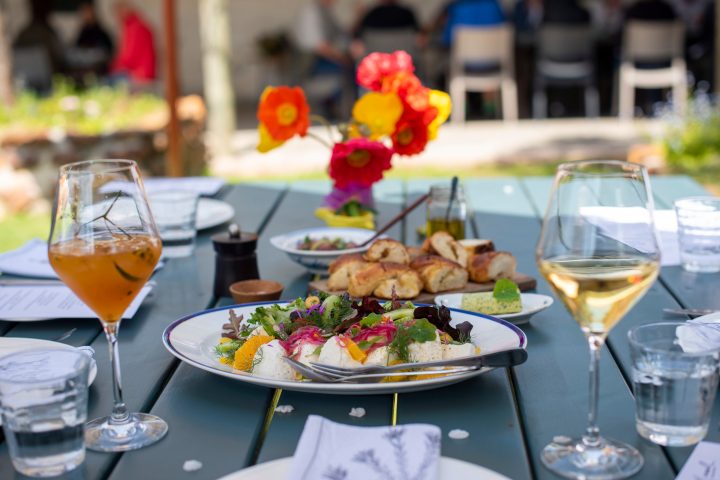
The story of a meal starts long before you sit down at the table. Visiting The Kraal at Joostenberg reveals the threads that connect food, farm and family, past, present and future.
The farm to table journey doesn’t get much shorter than at The Kraal at Joostenberg. Weekend lunches at this peaceful wine farm just off the N1 in Muldersvlei are steeped in the flavours of the five generations of the Myburgh family: old recipes, wild herbs, vegetables from the garden and the rest sourced from neighbouring farms. It’s a feast of what is local and in season. I joined one of their Saturday morning farm walks before lunch to meet the family and explore.

Susan Dehosse picks wild leeks beside the old farm road to flavour waterblommetjie bredie. (Photo: Kit Heathcock)
We’re walking up a farm road lined by ancient oak trees, vines on the slope above us and a wetland area below. Susan Dehosse picks a bunch of wild alliums with pretty white bell flowers from the verge and shows us the almost triangular stems and bulbs “These they call the three-cornered leek and we use them to flavour our waterblommetjie bredie.” I’ve already checked out the lunch menu for The Kraal today, and inhale the subtle oniony aroma in anticipation.
Another important bredie ingredient wanders past between the vines grazing on grass and weeds. Susan’s brother, Tyrrel Myburgh, explains their role in his organic management of the Joostenberg vineyards. “Our sheep graze through the vineyards in the winter, we’re trying to promote more biological activity in our soil. They drop manure as they go and keep the weeds down.” At the moment he says they have a herd of just 40 sheep, but are planning to build it up to about 250 over the next few years to be able to circulate through all 30 hectares of vineyards before they have to move them out in spring as the vines bud, “We don’t want them to eat the vine leaves!”
Joostenberg Wine Estate was established in 1696 and this farm track was once the main road linking Cape Town to Paarl. Now the N1 divides Joostenberg from its sister farm Klein Joostenberg, and the hum of traffic reminds us that despite feeling like a hidden rural idyll with its traditional Cape Dutch manor house and old farm buildings, Joostenberg is still connected to the flow of the modern world. The farm has been in the Myburgh family since the 1870s and the threads connecting past to present are visible at every turn. “My great grandparents planted these oaks,” says Susan. Her grandmother planted the geraniums that line the road, and her mother, Gillian Fairhead, was a knowledgeable gardener who built up a cut-flower business from the farm, now run by Tyrrel’s wife, Anette.
It takes all hands on deck for a family farm to flourish through changing times. “My dad is 81, still very much involved on the farm and he spends seven days a week hands-on running the butchery over at Klein Joostenberg,” says Tyrrel. He and his three siblings have inherited this hard-working and resourceful philosophy and each play complementary roles on the farm. Tyrrel and Philip resumed the winemaking tradition of Joostenberg in 1999, achieving full organic status in 2012. Tyrrel is the winemaker, while Philip works outside the farm as a lawyer but still finds time to be the marketing mind for the estate, and his wife Nicky is the force behind their renosterveld conservation and restoration efforts. Their sister Nicky works more at the bustling retail hub of Klein Joostenberg and her paintings hang in the wine tasting room here. And Susan, with her husband Christophe Dehosse, brought their classic French chef training and experience back to South Africa in the ’90s, making their name at Au Jardin in the Vineyard Hotel. Now they run the bistro and deli at Klein Joostenberg together, Christophe runs The Vine Bistro at Glenelly Wine Estate, and Susan opened The Kraal in 2018, offering leisurely al fresco weekend lunches in the old farm kraal.
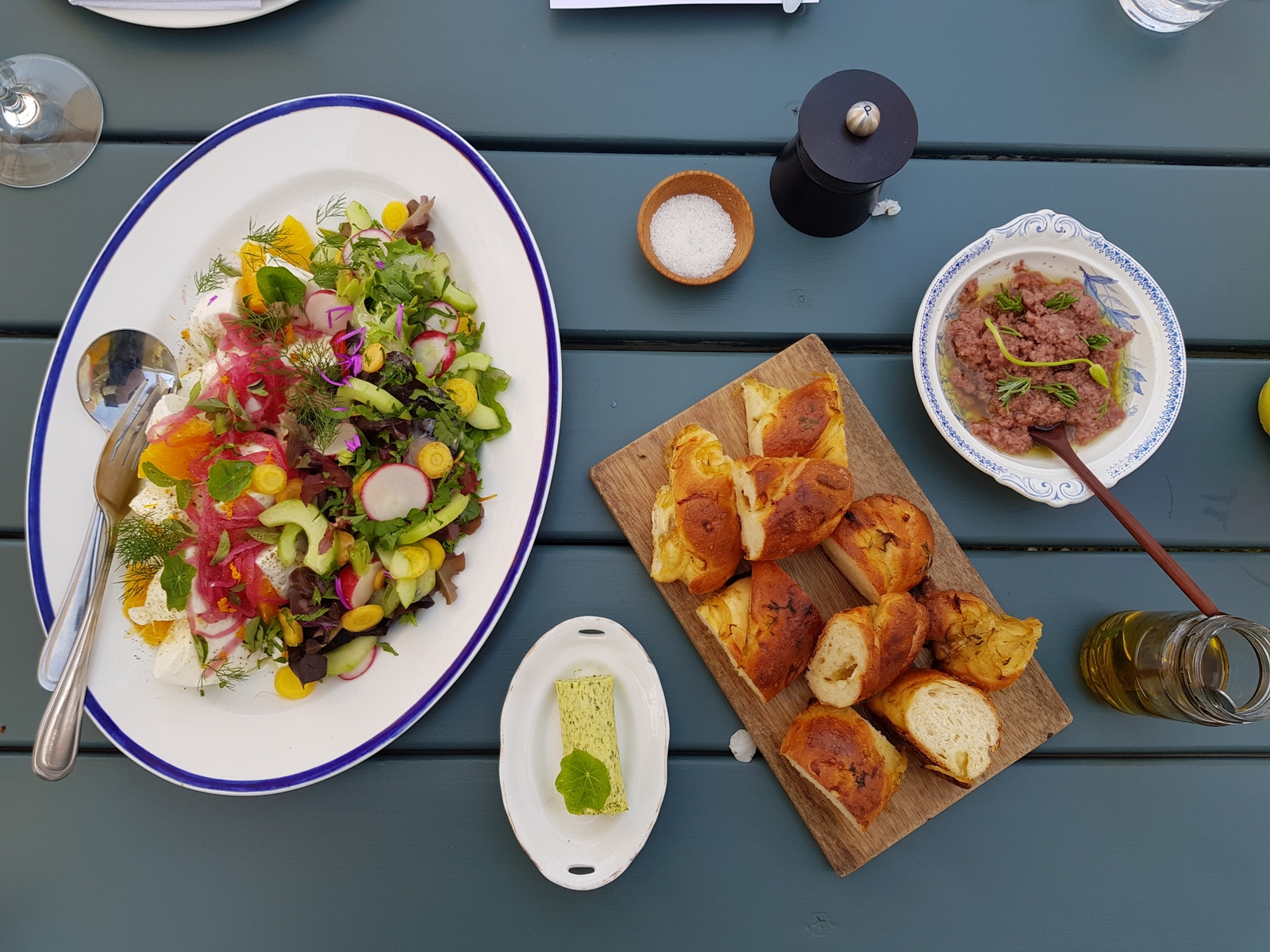
The bread keeps coming to mop up tapenade, nasturtium butter and crunchy farm salad with buffalo mozzarella. (Photo: Kit Heathcock)
Our walk meanders up the hill to overlook the farm and we hear about the elevated bush vine pruning style that Tyrrel prefers for his organic vineyard management, and what he uses for pest control. Not much, is the answer. Just a predatory wasp to control mealybugs, and the rest are no longer a problem with the biodiverse approach of organic agriculture.
A surprise wine tasting greets us in the lower vineyards. Tyrrel conjures up a picture of late March and April mornings when the mist from the vlei hangs over these lower slopes creating the ideal conditions for the “noble rot” essential to their Noble Late Harvest Chenin Blanc. “An interesting thing happens,” he says, “the grapes get infected by botrytis cinerea – which looks a little bit like red mould. Not very pretty but I kind of like rot, it’s beautiful! The berries get infected and the mould sucks moisture out of the berry, almost overnight the sugar content increases quite radically.” Sipping the golden nectar we can see why Tyrrel so loves an ugly red fungus – the wine is richly sweet with peach notes, a touch of marmalade, and just enough acidity. “For me the defining feature is the balance between sugar and acid,” he adds, “If you didn’t have the acid it would be like drinking a koeksister!”
Tyrrel and Susan bring out canapés of duck liver parfait with caramelised onions and fresh fennel, another of gorgonzola and preserved sour fig, and convincingly make a case for the wine to be served as an aperitif, rather than pigeon-holed as a dessert wine. “It goes beautifully with something rich like chicken liver pate. Serve it to your guests as they walk through the door, it gives them some energy and gets things going.”
Feeling enjoyably mellow, we wander down to a wild grassy area among oak trees beside the vlei, scattered with indigenous spring bulbs, where Nicky shares more about their renosterveld conservation efforts. “Our farm has been under plough for 250 years,” she says. “Renosterveld needs the same soil that farmers need, it needs fertile soil, as opposed to fynbos which thrives in infertile mountain soil, so that is why we only have 5% left.” As a family they are dedicated to preserving the corridors of uncultivated land that are left on the farm and Nicky and her son Philip (yes, there’s a Philip in every generation of the Myburgh family, sometimes more than one, among the cousins) are clearing the wetland area of invasive poplar trees, which get turned into mulch for the farm. Here they plan to re-introduce a variety of native waterblommetjies from another at-risk wetland area on the fringes of the farm. They don’t have enough of their own waterblommetjies to supply the restaurant, Susan tells me almost apologetically, but they’ve sourced them from Babylonstoren for today’s lunch.
We’ve come full circle now, winding through Nicky’s newly established renosterveld gardens to another quick wine tasting at the Manor House. I‘m delighted to spot a cheerful orange gladiolus alatus that grows at home on our Swartland smallholding, and realise that I need to read up more about renosterveld and its conservation from the book that Nicky carries everywhere, Dr Odette Curtis-Scott’s Field Guide to Renosterveld of the Overberg. But I’ve lingered botanising too long and lunch at The Kraal beckons.
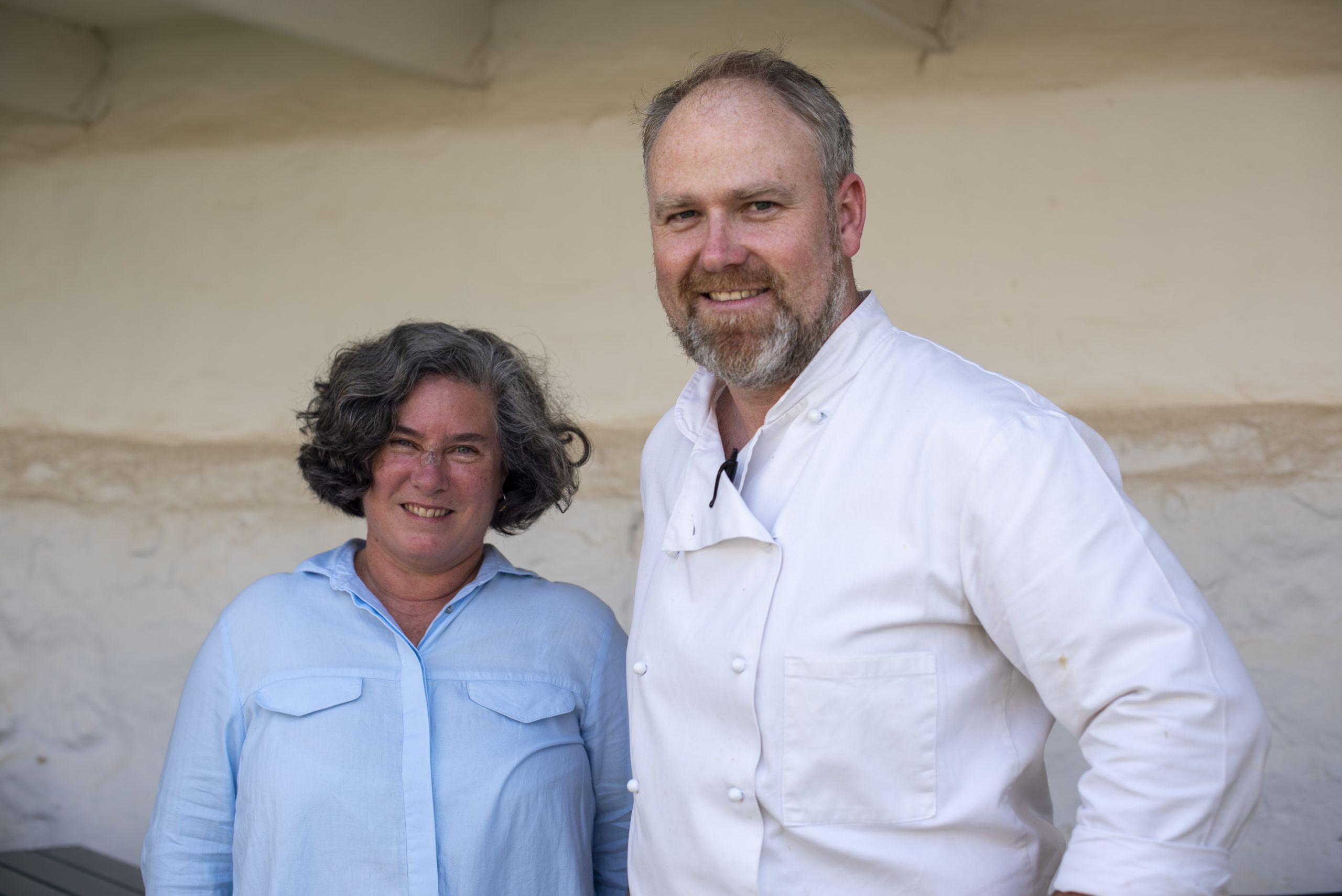
Susan Dehosse and Garth Bedford plan the weekend menus around what’s at its peak in the vegetable garden (Photo: Patrick Heathcock)
The spring sunshine emerges from the clouds and apricot blossoms drift over wooden tables in the grassed-over yard within the old whitewashed walls that used to shelter livestock. Pretty printed menus announce the three-course feast in store. “We decide the menu every week based on what’s available either here on the farm or from the two or three small-scale vegetable growers that we buy from at Klein Joostenberg,” says Susan. Chef Garth Bedford, who has been part of her and Christophe’s team for many years and is currently at the helm of The Kraal’s small kitchen, adds “often it will be something small and seasonal that makes us think of a particular dish, it can be as simple as asparagus or artichoke. This weekend it’s the waterblommetjies and the nasturtiums for the nasturtium butter. What’s prime right now”.
My family launches with enthusiasm into the first course, which fills the centre of the table – a wood platter piled with onion bread, bowls of tapenade, nasturtium butter, olive oil infused with wild rosemary, and a beautifully fresh and crunchy farm salad with thin pink strips of lightly pickled onion, and milky balls of fresh buffalo mozzarella from Zandam Cheese down the road. I ask about the dressing which is light and fragrant with orange “We use the pickling liquid from the onions, some oil and herbs,” Susan tells me.
After we’ve greedily accepted another round of bread to sop up all the flavours from the salad and tapenade, there’s a gentle pause before the table is laden with a new set of dishes. The waterblommetjie bredie that I’d been anticipating since the morning walk appears in a cast iron casserole. “It’s a very traditional South African dish and not unique by any means, but using the wild leeks and the suuring oxalis actually in the cooking gives it the most important flavour components,” says Susan.
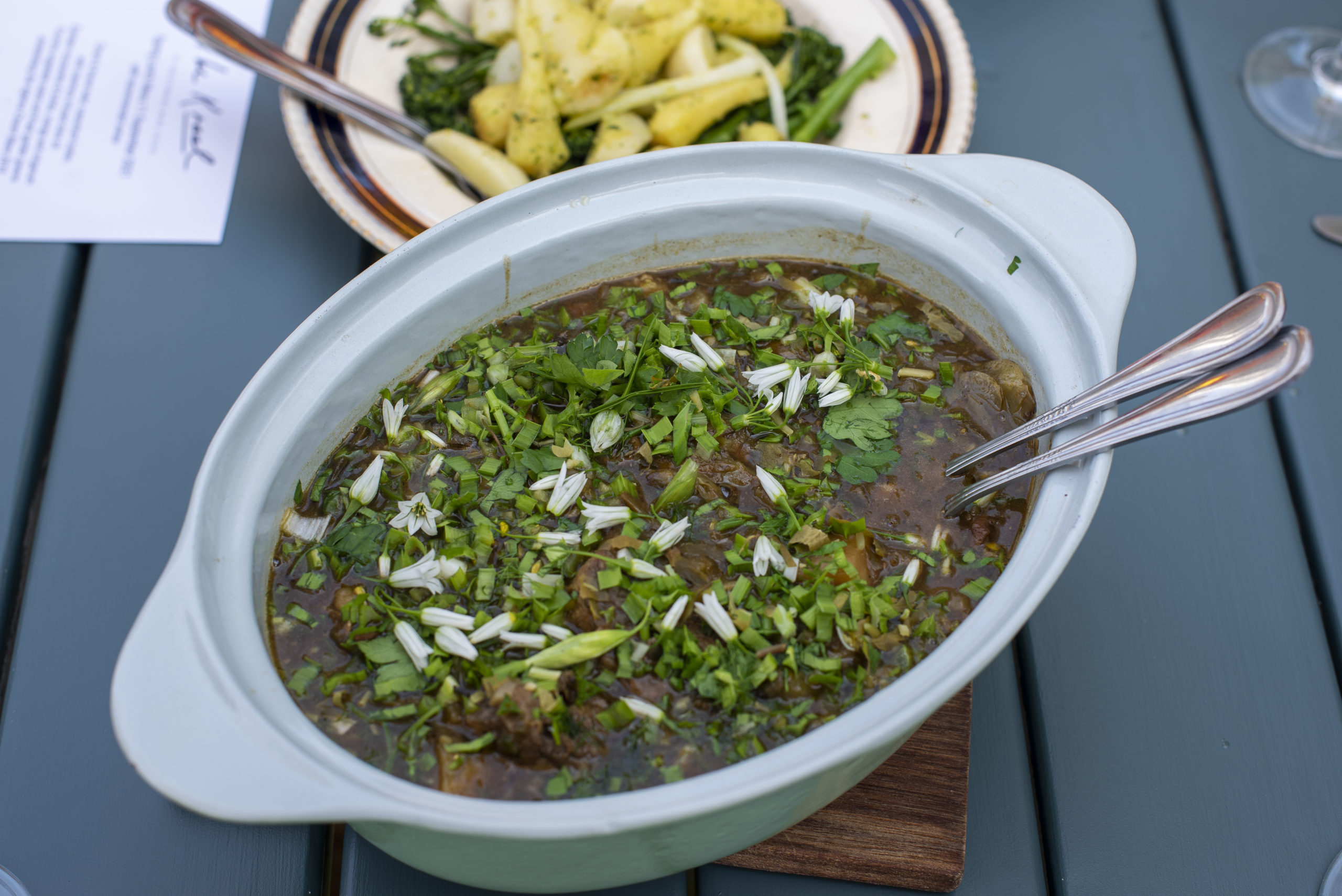
The waterblommetjie bredie is flavoured with wild leeks and suuring oxalis picked wild on the farm. (Photo: Kit Heathcock)
The lamb is their own from the farm this weekend, but they don’t yet have enough to supply the kitchen regularly. “Most of our ingredients come from within a 6km radius, although our meat comes from further afield. We get beef and venison from near Napier and Bredasdorp, free-range chickens from near Malmesbury.” Backed up by a rich leek gratin and some lightly roasted spring root vegetables, it’s a real feast and although there is more than enough for thirds, we reluctantly concede defeat, not managing to scrape the serving dishes clean.
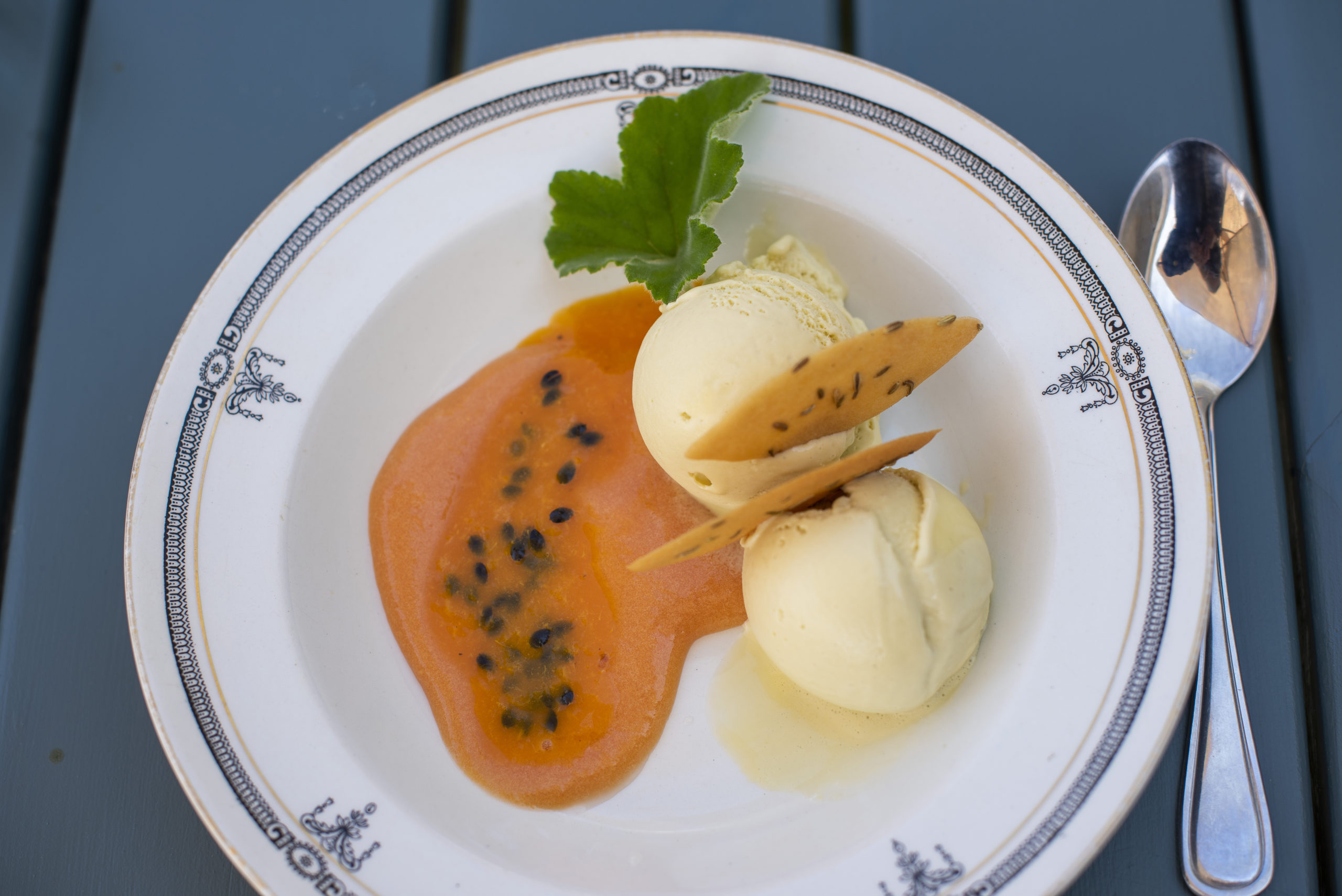
Mint pelargonium ice cream made by infusing the leaves overnight in the milk for the custard is a revelation of intense flavour. (Photo: Patrick Heathcock)
Dessert is firmly rooted on the farm, full of old-fashioned flavours. The mint pelargonium from their mother’s garden makes a fabulous rich and minty ice cream with herbaceous background notes, there are fennel seed crusted tuiles, and purées of guava and granadilla, fruits that may not be indigenous but have been part of South African country living for so long that they are entrenched in our collective food memories. I’m surprised to find that the mint actually goes well with the fruits. Somehow it lacks that ersatz mint spikiness of commercial ice cream, and although the pelargonium really is intensely minty, it gives the ice cream an almost buttery herbaceousness that softens the edges and allows the fruit to mingle without a clash.
All the threads of the generations of family farm living come together when you visit The Kraal for lunch – the age-old hospitality that makes you feel like a personal guest of the family, the bright colours of poppies from the cut-flower business, the renosterveld gardens full of spring bulbs flowering just outside the courtyard walls to wander and enjoy between courses, the wines from Tyrrel’s boutique winery, and of course the food, redolent with the flavours wild and cultivated that the family has grown up cooking with. DM/TGIFood
The Kraal, Joostenberg Wine Estate, Hoopenberg Road, Muldersvlei. See The Kraal. 079 64 11 320
The next farm walk is on 2 October. Book here.
The author supports Ladles of Love, currently feeding 30,000 people a day in the Western Cape. Please support them here.





 Become an Insider
Become an Insider
Comments - Please login in order to comment.